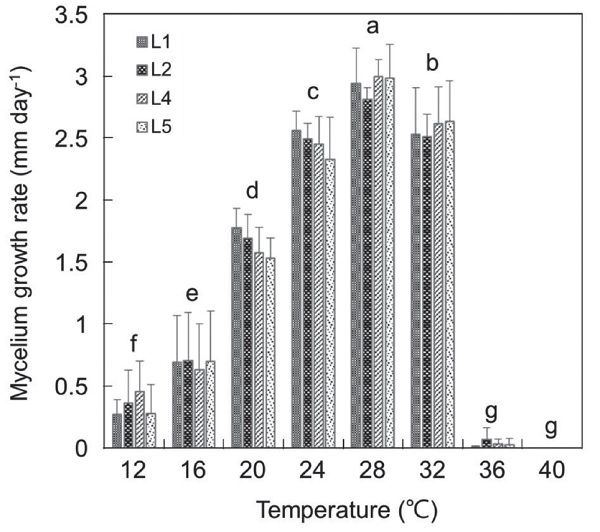All issues

Author:Yi-Nian Chen*, Dong-Hong Wu, Mei-Chun Chen, and Pei-Chen Chen
Abstract:
Climate change-related variations in temperature and precipitation may impact the ecology of certain plant pathogens and vectors that are sensitive to changes in humidity and temperature, which could, in turn, affect the incidence and temporal and spatial distribution of plant diseases. Previous research has shown that the rice blast fungus in Taiwan could be divided into 5 pathotype clusters based on virulence to Lijiangxintuanheigu monogenic lines (LTH MLs), with differences in habitat temperatures between these clusters. In this work, we investigated the effect of temperature on mycelial growth and sporulation of different pathotype clusters by analyzing 5 isolates from each of the 4 major clusters. Our findings indicated that the temperature range of 24–32℃ was optimal for the growth and reproduction of rice blast fungus in Taiwan. Among these temperatures, 28℃ was the most favorable. Conditions where the temperature fell below 20℃ or rose above 36℃ significantly restricted the growth and reproduction of the rice blast fungus. All isolates survived, albeit almost completely stopped growing at 36℃. Overall, clusters L4 and L5 exhibited better growth and reproduction at 32℃ compared to 24℃. Conversely, L1 and L2 showed superior growth and reproduction at 24℃ rather than 32℃. L4 had a significantly higher reproductive capacity than the other 3 clusters at 24–32℃. Because of this outcome and the consistent rise in average temperature since 2019, it was believed that temperature was the main cause of L4 and L5 becoming the prevalent clusters in Taiwan. This study clearly illustrated the impact of temperature changes on the epidemic spread of rice blast fungus in Taiwan. It also offered crucial guidance for developing disease-resistant plans for potential climate change scenarios.
Key words:Climate change, Mycelial growth rate, Pyricularia oryzae, Sporulation, Temperature
Download:![]() PDF Links
PDF Links
 Submit your manuscript
Submit your manuscript
 Guide for authors
Guide for authors